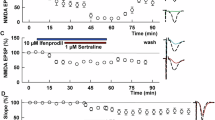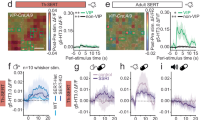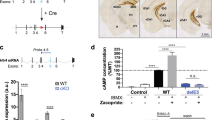Abstract
Serotonin-containing neurones in brain have been proposed to have a role in the control of physiological mechanisms such as sleep, thermoregulation, pain perception and endocrine secretions as well as in the physiopathology of migraine or depressive illness1–6. One difficulty in testing these possibilities lies in the scarcity of pharmacological agents able to interact selectively with the probably multiple classes of serotonin receptors in the central nervous system. Development of such agents would be facilitated by simple in vitro models in which biological responses to serotonin in mammalian brain could be quantified. Thus a serotonin-sensitive adenylate cyclase has been characterized in rat brain, but the response to serotonin is weak in newborn and practically absent in adult animals7–11. In addition, two pharmacologically distinct classes of serotoninergic binding site have been identified using 3H-serotonin and 3H-spiperone as ligands12–17, but their identification as receptors remains to be established. More recently, serotonin has been shown to stimulate phosphorylation of a neuronal protein in slices from the facial motor nucleus, although the receptors mediating this action were not characterized18. We now report that serotonin stimulates glycogen hydrolysis in slices of cerebral cortex, that this action is mediated by a novel class of receptors and that tricyclic antidepressants are among the best competitive antagonists of the indolamine.
This is a preview of subscription content, access via your institution
Access options
Subscribe to this journal
Receive 51 print issues and online access
$199.00 per year
only $3.90 per issue
Buy this article
- Purchase on SpringerLink
- Instant access to full article PDF
Prices may be subject to local taxes which are calculated during checkout
Similar content being viewed by others

References
Barchas, J. & Udsin, E. (eds) in Serotonin and Behavior, 1–316 (Academic, New York, 1973).
Fuxe, K., Schubert, J., Hokfelt, T. & Jonsson, G. Adv. biochem. Psychopharmac. 10, 67–74 (1974).
Green, A. R. & Grahame-Smith, Nature 260, 487–491 (1976).
Aghajanian, G. K. & Wand, R. Y. in Psychopharmacology: A Generation of Progress (eds Lipton, M. A., Di Mascio, A. & Killam, K. F.) 171–193 (Raven, New York, 1978).
Besson, J. M. Pain and Society 17, 161–182 (1980).
Garver, D. L. & Davis, J. M. Life Sci. 24, 383–394 (1979).
Von Hungen, K., Roberts, S. & Hill, D. F. Brain Res. 84, 257–267 (1975).
Enjalbert, A., Bourgoin, S., Hamon, M., Adrien, J. & Bockaert, J. Molec. Pharmac. 14, 2–10 (1978).
Enjalbert, A., Hamon, M., Bourgoin, S. & Bockaert, J. Molec. Pharmac. 14, 11–23 (1978).
Fillion, G. et al. Life Sci. 24, 1813–1819 (1979).
Nelson, D., Herbet, A., Enjalbert, A., Bockaert, J. & Hamon, M. Biochem. Pharmac. 29, 2445–2453 (1980).
Fillion, G. M. B. et al. Molec. Pharmac. 14, 50–59 (1978).
Nelson, D. L., Herbert, A., Bourgoin, S., Glowinski, J. & Hamon, M. Molec. Pharmac. 14, 983–995 (1978).
Peroutka, S. J. & Snyder, S. H. Molec. Pharmac. 16, 687–699 (1979).
Leysen, J. E. et al. Life Sci. 28, 1015–1022 (1981).
Leysen, J. E. J. Physiol., Paris 77, 351–362 (1981).
Peroutka, S. J., Lebovitz, R. M. & Snyder, S. H. Science 212, 827–829 (1981).
Dolphin, A. C. & Greengard, P. Nature 289, 76–79 (1981).
Quach, T. T., Rose, C. & Schwartz, J. C. J. Neurochem. 30, 1335–1341 (1978).
Edwards, C., Nahorski, S. R. & Rogers, K. J. J. Neurochem. 22, 564–572 (1974).
Schwartz, J. C., Martres, M. P., Rose, C., Quach, T. T. & Sokoloff, P. in Chemical Neurotransmission, 75 Years (eds Stjärne, L., Hedkvist, P., Lagercrantz, H. & Wennmalm, A.) 411–423 (Academic, New York, 1981).
Quach, T. T., Duchemin, A. M., Rose, C. & Schwartz, J. C. Molec. Pharmac. 17, 301–308 (1980).
Magistretti, P., Morrisson, J. H., Shoemaker, W. J., Sapin, V. & Bloom, F. E. Proc. natn. Acad. Sci. U.S.A. 78, 6535–6539 (1981).
Sutherland, E. W. & Robison, G. A. Pharmac. Rev. 18, 145–164 (1966).
Haylett, D. G. & Jenkinson, D. H. J. Physiol., Lond. 225, 751–772 (1972).
Assimacopoulos Jeannet, F. O., Blackmore, P. F. & Exton, J. J. biol. Chem. 252, 2662–2669 (1977).
Koizumi, J. Prog. Histochem. Cytochem. 6, 1–37 (1974).
Dahlstrom, A. & Fuxe, K. Acta physiol. scand. 62, 1–35 (1964).
Dahlstrom, A., Haggendal, J. & Atack, C. in Serotonin and Behavior (eds Barchas, J. & Usdin, E.) 87–96 (Academic, New York, 1973).
Garbarg, M., Barbin, G., Feger, T. & Schwartz, J. C. Science 186, 833–835 (1974).
Seeman, P. Pharmac. Rev. 32, 229–313 (1980).
Ross, S. B., Renyi, A. L. & Ogren, S. O. Life Sci. 10, 1267–1277 (1971).
Maas, J. W. Archs gen. Psychiat. 32, 1357–1361 (1975).
Glassman, A. H. & Perel, J. M. in Psychopharmacology: A Generation of Progress (eds Lipton, M. A., Di Mascio, A. & Killam, K. F.) 917–922 (Raven, New York, 1979).
Cheng, C. & Prussoff, W. H. Biochem. Pharmac. 22, 3099–3108 (1973).
Parker, R. B. & Waud, D. R. J. Pharmac. exp. Ther. 177, 1–24 (1971).
Author information
Authors and Affiliations
Rights and permissions
About this article
Cite this article
Quach, T., Rose, C., Duchemin, A. et al. Glycogenolysis induced by serotonin in brain: identification of a new class of receptor. Nature 298, 373–375 (1982). https://doi.org/10.1038/298373a0
Received:
Accepted:
Issue date:
DOI: https://doi.org/10.1038/298373a0
This article is cited by
-
Reflections on glycogen and β-amyloid: why does glycogenolytic β2-adrenoceptor stimulation not rescue memory after β-amyloid?
Metabolic Brain Disease (2015)
-
Monoaminergic Control of Cellular Glucose Utilization by Glycogenolysis in Neocortex and Hippocampus
Neurochemical Research (2015)
-
Correlation between carbohydrate and catecholamine level impairments in methionine sulfoximine epileptogenic rat brain
Neurochemical Research (1990)
-
Possible involvement of indolamines in the glycogenic effect of the convulsant methionine sulfoximine in rat brain
Experientia (1990)


